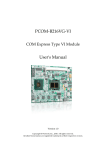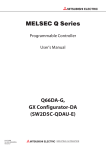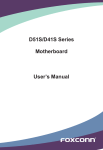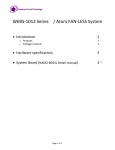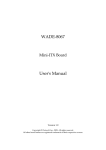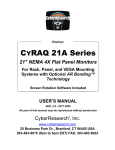Download RUBY-M710VG2AR User`s Manual
Transcript
RUBY-M710VG2AR Industrial Mainboard User's Manual Version 1.0 Copyright © Portwell, Inc., 2010. All rights reserved. All other brand names are registered trademarks of their respective owners. Preface Table of Contents How to Use This Manual Chapter 1 System Overview.......................................................................................................1-1 1.1 Introduction ....................................................................................................... 1-1 1.2 Check List........................................................................................................... 1-1 1.3 Product Specification........................................................................................ 1-1 System Configuration............................................................................................. 1-3 1.3.1 Mechanical Drawing................................................................................ 1-4 1.4 System Architecture.......................................................................................... 1-6 Chapter 2 Hardware Configuration ...........................................................................................2-1 2.1 Jumper Setting ................................................................................................... 2-2 2.2 Connector Allocation........................................................................................ 2-3 Chapter 3 System Installation....................................................................................................3-1 3.1 Intel® i7/i5/P4500 PGA .................................................................................. 3-1 3.2 Main Memory .................................................................................................... 3-1 3.3 Installing the Single Board Computer............................................................ 3-2 3.3.1 Chipset Component Driver .................................................................... 3-2 3.3.2 Intel® Integrated HD Graphics Controller........................................... 3-2 3.3.3 Intel Gigabit Ethernet Controller ........................................................... 3-3 3.3.4 Audio Controller ...................................................................................... 3-3 3.4 Clear CMOS Operation .................................................................................... 3-3 3.5 WDT Function ................................................................................................... 3-3 3.6 GPIO.................................................................................................................... 3-9 3.6.1 Pin assignment ......................................................................................... 3-9 3.6.2 GPIO Programming Guide..................................................................... 3-9 3.6.3 Example ................................................................................................... 3-10 Chapter 4 BIOS Setup Information............................................................................................4-1 4.1 Entering Setup -- Launch System Setup ........................................................ 4-1 4.2 Main .................................................................................................................... 4-3 4.3 Advanced ........................................................................................................... 4-4 4.4 Chipset.............................................................................................................. 4-25 4.5 Boot ................................................................................................................... 4-31 4.6 Security ............................................................................................................. 4-34 4.7 Save & Exit ....................................................................................................... 4-35 Chapter 5 Troubleshooting ........................................................................................................5-1 5.1 Hardware Quick Installation........................................................................... 5-1 5.2 BIOS Setting ....................................................................................................... 5-2 5.3 FAQ ..................................................................................................................... 5-3 Appendix A Appendix B Preface How to Use This Manual The manual describes how to configure your RUBY-M710VG2AR system to meet various operating requirements. It is divided into five chapters, with each chapter addressing a basic concept and operation of Industrial Main Board. Chapter 1 : System Overview. Presents what you have in the box and give you an overview of the product specifications and basic system architecture for this series model of single board computer. Chapter 2 : Hardware Configuration. Shows the definitions and locations of Jumpers and Connectors that you can easily configure your system. Chapter 3 : System Installation. Describes how to properly mount the CPU, main and memory to get a safe installation and provides a programming guide of Watch Dog Timer function. Chapter 4 : BIOS Setup Information. Specifies the meaning of each setup parameters, how to get advanced BIOS performance and update new BIOS. In addition, POST checkpoint list will give users some guidelines of trouble-shooting. Chapter 5 : Troubleshooting. Provides various useful tips to quickly get RUBY710VG2AR running with success. As basic hardware installation has been addressed in Chapter 3, this chapter will basically focus on system integration issues, in terms of backplane setup, BIOS setting, and OS diagnostics. The content of this manual and EC declaration document is subject to change without prior notice. These changes will be incorporated in new editions of the document. Portwell may make supplement or change in the products described in this document at any time. Updates to this manual, technical clarification, and answers to frequently asked questions will be shown on the following web site : http://www.portwell.com.tw/. System Overview Chapter 1 System Overview 1.1 Introduction RUBY-M710VG2AR aimed squarely at customers who seek significant computing performance and lower power consumption improvements, Portwell’s RUBYM710VG2AR is the perfect tool to help them build the best environmentally friendly, greener embedded PC solutions. RUBY-M710VG2AR is based on Intel’s Mobile QM57 Express Chipset supporting the latest Intel® Core™ i5/i7 processors by ATX form factor. It is the ideal solution for Green PC and applications in such areas as Point-of-Sale (POS), lottery, medical, gaming, digital signage, surveillance security monitoring and kiosks. RUBY-M710VG2AR features two 240-pin DIMM sockets to support dual-channel DDR3 1066/800 SDRAM up to 8GB; dual display via VGA/DVI-D/HDMI/LVDS; one PCI-E x16, one PCI-E x4, one PCI-E x1, four PCI expansion slots and one Mini PCI-E socket; dual Intel® GbE LANs (one of which can support iAMT 6.0); plus six SATA (supporting RAID 0, 1, 5, 10), Audio and USB. The new RUBY-M710VG2AR also provides legacy support for Intel® Celeron® processor P4500. 1.2 Check List The RUBY-M710VG2AR package should cover the following basic items: 9 9 9 9 One RUBY-M710VG2AR Industrial Main Board Two SATA 300 cables One I/O Shield One Installation Resources CD-Title If any of these items is damaged or missing, please contact your vendor and keep all packing materials for future replacement and maintenance. 1.3 Product Specification z Main processor - Intel®Core™ i5 / i7 processor - FSB: 1333/1066/800MHz z Chipset Intel® QM57 chipset z BIOS uEFI BIOS RUBY-M710VG2AR User’s Manual 1-1 System Overview z Main Memory - Support dual-channel DDR3 memory interface - Non-ECC, non-buffered DIMMs only - Two 240-pin DIMM sockets support up to 8GB DDR3 800/1066 SDRAM z Expansion Interface - Four 32-bit PCI expansion slots - One PCIex16 Slot (Support PCIex1, PCIex4, PCIex8, PCIex16 Mode, only Graphics card can be supported, for other requests please contact technical support) - One PCIex4 Slot - One PCIex1 Slot - One Mini-PCIe Socket z SATA Interface Six SATA 300 ports z Serial Ports Support six serial ports, (One RS232 & One RS232/422/485 selectable at rear IO, Four RS232 with headers) z USB Interface Support eight USB ports (four ports at rear I/O; four ports internal) z PS/2 Mouse and Keyboard Interface Support dual 6-pin mini-DIN connector at rear I/O panel for PS/2 keyboard/mouse z Audio Interface 3 Audio jacks for Line-in/Line-out/MIC z Watchdog Timer Support WDT function through software programming for enable/disable and interval setting Generate system reset z On-board VGA GMCH integrated Intel Graphics Media Accelerator X4500 (Intel GMA X4500) z On-board Ethernet LAN Two Gigabit Ethernet (10/100/1000 Mbits/sec) LAN ports using Intel 82574L and 82577LM GbE Ethernet Controller z High Driving GPIO Onboard programmable 16-bit Digital I/Os (8x In/Out) z Cooling Fans Support one 3-pin power connector for CPU cooler and one 3-pin power connector for system z System Monitoring Feature Monitor CPU temperature, system temperature and major power sources, etc RUBY-M710VG2AR User’s Manual 1-2 System Overview z Outline Dimension (L X W): 305mm (12”) X 244mm (9.6”) z Operating Temperature: 0°C ~ 55°C z Storage Temperature: -20°C ~ 80°C z Relative Humidity: 5% ~ 90%, non-condensing z Power Requirements: Run Burning Test V6.0 RUN time: 10 / 30 Minutes. No Back plane Full Loading Full Loading 30Min Item Power ON 10Min CPU +12V System +12V System +3.3V System +5V System+ Device +12V System+ Device +5V USB Loading Test 0.70A 0.26A 1.08A 2.54A 2.11A 3.28A 1.10A 0.33A 1.07A 2.95A 1.60A 3.63A 4.70V/ 530mA 1.06A 0.35A 1.07A 3.06A 1.63A 3.62A z Configuration: System Configuration CPU Type SBC BIOS Intel® Core™ i7 CPU M620 2.67GHz (ES) Bus Speed:133.0MHz L3:4M Portwell, Inc. RUBY-M710 BIOS Rev.: R1.00.E0 (09132010) Memory Apacer PC3-8500 1GB*1 (ELPIDA J1108BABG-DJ-E) VGA Card Onboard Intel® Arrandale Graphics Media Accelerator HD VGA Driver Intel® Graphics Media Accelerator HD Version 6.14.10.5189 LAN Card Onboard Intel® 82574L / 82577LM Gigabit Network Connection LAN Driver Audio Card Intel® 82574L / 82577LM Gigabit Network Connection Version 11.4.7.0 / 11.6.92.0 Onboard Realtek ALC888 High Definition Audio Controller Audio Driver Realtek ALC888 High Definition Audio Version 5.10.0.6043 Chipset Driver Intel® Chipset Device Software Version 9.1.1.1025 SATA HDD WD WD1500ADFD 150GB Power Supply Sunpower SPX-6500P1 500W RUBY-M710VG2AR User’s Manual 1-3 System Overview 1.3.1 Mechanical Drawing RUBY-M710VG2AR User’s Manual 1-4 System Overview RUBY-M710VG2AR User’s Manual 1-5 System Overview 1.4 System Architecture RUBY-M710VG2AR System Block Diagram RUBY-M710VG2AR User’s Manual 1-6 Hardware Configuration Chapter 2 Hardware Configuration This chapter indicates jumpers’, headers’ and connectors’ locations. Users may find useful information related to hardware settings in this chapter. The jumper settings are schematically depicted in this manual as follows: RUBY-M710VG2AR User’s Manual 2-1 Hardware Configuration 2.1 Jumper Setting For users to customize RUBY-M710VG2AR_ZR0 ’s features. In the following sections, Short meanscovering a jumper cap over jumper pins; Open or N/C (Not Connected) means removing a jumper cap from jumper pins. Users can refer to Figure above for the Jumper allocations. z Jump Setting List JP6、JP11 : For Debug JP1: COM2 RS232, 422, 485 Selection JP1 5-6,9-11,10-12,15-17,16-18 Short 3-4,7-9,8-10,13-15,14-16,21-22 Short 1-2,7-9,8-10,19-20 Short Function RS-232 Ì RS-422 RS-485 JP5: VDDLVDS_IN Selection JP5 1-2 Short 5-6 Short 3-4 Short Function VCC3 VCC +12V Ì JP7: LVDS BACKLIGHT_ENABLE JP7 1-3,2-4 Short 1-3,4-6 Short 3-5,2-4 Short 3-5,4-6 Short Function 5V, Active High Ì 12V, Active High 5V, Active Low 12V, Active Low JP9: CMOS Clear Header JP9 1-2 Open 1-2 Short Function Normal Operation Ì Clear CMOS Contents JP8: SECOND CMOS Clear Header JP9 1-2 Open 1-2 Short Function Normal Operation Ì Clear CMOS Contents RUBY-M710VG2AR User’s Manual 2-2 Hardware Configuration 2.2 Connector Allocation I/O peripheral devices are connected to the interface connectors. Connector Function List Connector JP2 Function LAN LED Pin Header JP3 WDT LED Pin Header JP4 Front Panel Pin Header JP10 Backlight Power Connector JP12 LPC Debug Pin Header J3 DVI-D +VGA CONNECTOR J4 COM1+COM2 CONNECTOR J5 AUDIO CONNECTOR J6 USBX2 + LAN CONNECTOR J7 USBX2 + LAN CONNECTOR J8 SYS FAN CONNECTOR J9 16-bit GPIO Pin Header J10 PCI-E X4 SLOT J11 K/B & M/S Pin Header J14 PCI SLOT J15 PCI SLOT J16 PCI SLOT J17 PCI SLOT J18 ATX 4P CONNECTOR J19 LVDS CONNECTOR J20 CPU FAN CONNECTOR J21 PCI-E X1 SLOT J22 PCI-E X16 SLOT J23 SMBUS Pin Header J24 USBx2 Pin Header J25 MINI PCIE CONNECTOR J26 USBx2 Pin Header J27,J29 DDR3 LONG-DIMM RUBY-M710VG2AR User’s Manual Remark Upside is COM2 2-3 Hardware Configuration J28 TPM1.2 PIN Header J30 SATA CONNECTOR (PORT 4) J31 SATA CONNECTOR (PORT 1) J32 SATA CONNECTOR (PORT 5) J33 SATA CONNECTOR (PORT 3) J34 SATA CONNECTOR (PORT 2) J35 SATA CONNECTOR (PORT 0) J36 ATX 24P CONNECTOR J37 RS232 COM6 PIN Header J38 RS232 COM5 PIN Header J39 RS232 COM4 PIN Header J40 RS232 COM3 PIN Header Pin Assignments of Connectors JP2: LAN LED Pin Header PIN No. 1 3 5 7 Signal Description 577LM_LED_1000# 577LM_LED_100# +3.3V 577LM_LED_LNK#_ACT PIN No. 2 4 6 8 Signal Description 574LM_LED_1000# 574LM_LED_100# +3.3V 574L_ LED_LNK PIN No. 2 4 6 8 10 12 14 Signal Description JP4: Front Panel Pin Header PIN No. 1 3 5 7 9 11 13 Signal Description VCC HD_LED# GND RESET# N/A GND VCC VCC PWR_LED PWRBTN GND N/A GND KEY JP10: Backlight POWER CONNECTOR Pin No. 1 2 3 4 5 Signal Description ENABLE GND +12V GND VCC RUBY-M710VG2AR User’s Manual 2-4 Hardware Configuration RUBY-M710VG2AR User’s Manual 2-5 Hardware Configuration JP12: LPC Debug Pin header PIN No. 6 7 8 9 10 Signal Description LAD0 LAD1 LAD2 LAD3 KEY PIN No. 1 2 3 4 5 Signal Description VCC3 PLT_RST# LFRAME# CLOCK GND J8: SYS FAN CONNECTOR Pin No. 1 2 3 Signal Description PWM_CONTROL +12V SENSE J9: 16-bit GPIO PIN No. 1 3 5 7 9 11 13 15 17 Signal Description GPIO11 GPIO12 GPIO30 GPIO31 GPIO70 GPIO71 GPIO72 GPIO73 GND PIN No. 2 4 6 8 10 12 14 16 18 Signal Description GPIO32 GPIO33 GPIO36 GPIO37 GPIO74 GPIO75 GPIO76 GPIO77 GND PIN No. 2 X 6 8 10 Signal Description KB_DAT X GND 5V KB_CLK J11 : K/B & M/S Pin Header PIN No. 1 X 5 7 9 Signal Description MS_DAT X GND 5V MS_CLK RUBY-M710VG2AR User’s Manual 2-6 Hardware Configuration J19: LVDS CONNECTOR Pin No. 2 4 6 8 10 12 14 16 18 20 22 24 26 28 30 Signal Description VDD LVDSA_DATA#0 LVDSA_DATA#1 LVDSA_DATA#2 LVDSA_DATA#3 LVDSA_CLKN LVDS_DDC_DATA GND LVDSB_DATA#0 LVDSB_DATA#1 LVDSB_DATA#2 LVDSB_DATA#3 LVDSB_CLKN NC GND Pin No. 1 3 5 7 9 11 13 15 17 19 21 23 25 27 29 Signal Description VDD LVDSA_DATA0 LVDSA_DATA1 LVDSA_DATA2 LVDSA_DATA3 LVDSA_CLKP LVDS_DDC_CLK GND LVDSB_DATA0 LVDSB_DATA1 LVDSB_DATA2 LVDSB_DATA3 LVDSB_CLKP NC GND J20: CPU Fan connector Pin No. 1 2 3 4 Signal Description GND +12V PWM_CONTROL SENSE J23: SMBUS Pin Header Pin No. 1 2 3 4 5 Signal Description SMB_CLK X GND SMB_DATA VCC J24 & J26: USBx2 Pin Header PIN No. 1 3 5 7 9 Signal Description VCC DATA DATA + GND KEY RUBY-M710VG2AR User’s Manual PIN No. 2 4 6 8 10 Signal Description VCC DATA DATA + GND GND 2-7 Hardware Configuration J28: TPM1.2 PIN Header PIN No. 1 3 5 7 9 11 13 15 17 19 Signal Description PCLK_TPM LFRAME# RUF_PLT_RST# LAD3 VCC3 LAD0 SMB_CLK_S 3V_DUAL GND LPCPD RUBY-M710VG2AR User’s Manual PIN No. 2 4 6 8 10 12 14 16 18 20 Signal Description GND X VCC LAD2 LAD1 GND SMB_DATA_S SERIRQ X X 2-8 System Installation Chapter 3 System Installation This chapter provides you with instructions to set up your system. The additional information is enclosed to help you set up onboard PCI device and handle Watch Dog Timer (WDT) and operation of GPIO in software programming. 3.1 Intel® i7/i5/P4500 PGA RUBY-M710VG2AR has equipped the most advanced Intel® Core i7/i5 series CPUs which has built-in Intel® HD Graphics Controller providing a total solution of multipurpose operation. Further more, the leading-edge Intel® Core™ processor delivers unmatched technology for intelligent performance on the most demanding tasks, such as creating digital video and playing intense games. With building into RUBYM710VG2AR module, it can be applied in many different uses depending on the function of carrier board. CPU Support List 3.2 Intel® Core i7-620M Intel® Core i5-520M Intel® P4500 Main Memory RUBY-M710VG2AR provide 2 x 240pin Long-DIMM sockets which supports 800/1066 DDR3-SDRAM as main memory Non-ECC, non-register type of functions. The maximum memory can be up to 8GB. Memory clock and related settings can be detected by BIOS via SPD interface. For system compatibility and stability, do not use memory module without brand. Memory configuration can be set to either one double-sided DIMM in one DIMM socket or two single-sided SO-DIMM in both sockets. Beware of the connection and lock integrity from memory module to socket. Inserting improperly it will affect the system reliability. Before locking, make sure that all modules have been fully inserted into the card slots. Memory Frequency 800 1066 Single Channel DDR Bandwidth 12.8 GB/s 17 GB/s RUBY-M710VG2AR User’s Manual 3-1 System Installation Note: To insure the system stability, please do not change any of DRAM parameters in BIOS setup to modify system the performance without acquired technical information. 3.3 Installing the Single Board Computer To install your RUBY-M710VG2AR into standard chassis or proprietary environment, please perform the following: Step 1 : Check all jumpers setting on proper position Step 2 : Install and configure CPU and memory module on right position Step 3 : Place RUBY-M710VG2AR into the dedicated position in the system Step 4 : Attach cables to existing peripheral devices and secure it WARNING Please ensure that SBC is properly inserted and fixed by mechanism. Note Please refer to section 3.3.1 to 3.3.7 to install INF/VGA/LAN/Audio drivers. 3.3.1 Chipset Component Driver RUBY-M710VG2AR uses state-of-art Intel® QM57 chipset. It’s a new chipset that some old operating systems might not be able to recognize. To overcome this compatibility issue, for Windows Operating Systems such as Windows XP/Vista/Win7, please install its INF before any of other Drivers are installed. You can find very easily this chipset component driver in RUBY-M710VG2AR CD-title. 3.3.2 Intel® Integrated HD Graphics Controller Unlike the other structure, RUBY-M710VG2AR has integrated HD Graphics derived from Intel® Core series CPU (i5/i7). It’s the most advanced design to gain an outstanding graphic performance. Shared 8 accompany it to 256MB system DDR3SDRAM with Total Graphics Memory. RUBY-M710VG2AR supports VGA, DVI, LVDS, HDMI. This combination makes RUBY-M710VG2AR an excellent piece of multimedia hardware. With no additional video adaptor, this onboard video will usually be the system display output. By adjusting the BIOS setting to disable on-board VGA, an add-on PCI-Express graphic card can take over the system display. Drivers Support Please find all the drivers in the RUBY-M710VG2AR CD-title. Drivers support , Windows XP/Vista/Win7. RUBY-M710VG2AR User’s Manual 3-2 System Installation 3.3.3 Intel Gigabit Ethernet Controller Drivers Support Please find INTEL 82577LM & 82574L LAN driver in /Ethernet directory of RUBYM710VG2AR CD-title. The drivers support Windows XP/Vista/Win7. 3.3.4 Audio Controller Please find Intel® High Definition Audio driver form RUBY-M710VG2AR CD-title. The drivers support Windows XP/Vista/Win7. 3.4 Clear CMOS Operation The following table indicates how to enable/disable Clear CMOS Function hardware circuit by putting jumpers at proper position. JP9: CMOS Clear Header JP9 1-2 Open 1-2 Short 3.5 Function Normal Operation Clear CMOS Contents WDT Function The working algorithm of the WDT function can be simply described as a counting process. The Time-Out Interval can be set through software programming. The availability of the time-out interval settings by software or hardware varies from boards to boards. RUBY-M710VG2AR allows users control WDT through dynamic software programming. The WDT starts counting when it is activated. It sends out a signal to system reset or to non-maskable interrupt (NMI), when time-out interval ends. To prevent the time-out interval from running out, a re-trigger signal will need to be sent before the counting reaches its end. This action will restart the counting process. A well-written WDT program should keep the counting process running under normal condition. WDT should never generate a system reset or NMI signal unless the system runs into troubles. The related Control Registers of WDT are all included in the following sample program that is written in Assembly language. User can fill a non-zero value into the Time-out Value Register to enable/refresh WDT. System will be reset after the Timeout Value to be counted down to zero. Or user can directly fill a zero value into Time-out Value Register to disable WDT immediately. To ensure a successful RUBY-M710VG2AR User’s Manual 3-3 System Installation accessing to the content of desired Control Register, the sequence of following program codes should be step-by-step run again when each register is accessed. Additionally, there are maximum 2 seconds of counting tolerance that should be considered into user’ application program. For more information about WDT, please refer to ITE8721 data sheet. There are two PNP I/O port addresses that can be used to configure WDT, 1) 0x2E:Test 1 Register 2) 0x2F:Test 2 Register Below are some example codes, which demonstrate the use of WDT .model small .386p .stack .data ADDRESS dw .code pgm: mov ADDRESS,002eh mov dx, ADDRESS mov al, 87h out dx, al mov al, 01h out dx, al mov al, 55h out dx, al mov al, 55h out dx, al 0FFFFh ; I suppose 2Eh that is the address of SIO ; enter MB PnP mode in 2Eh mov al, 20h ; read the Chip ID to check the address of SIO out dx, al inc dx in al, dx ; default =87h mov bl, al mov al, 21h mov dx, ADDRESS out dx, al inc dx in al, dx ; default =21h mov bh, al cmp bx, je 2187h ;cmp CHIP ID L1 RUBY-M710VG2AR User’s Manual 3-4 System Installation mov ADDRESS,4eh ; SIO in 4Eh mov dx, ADDRESS ; enter MB PnP mode in 4Eh mov al, 87h out dx, al mov al, 01h out dx, al mov al, 55h out dx, al mov al, 0AAh out dx, al mov al, 20h ; read the Chip ID to check the address of SIO out dx, al inc dx in al, dx ; default =87h mov bl, al mov al, 21h mov dx, ADDRESS out dx, al inc dx in al, dx ; default =21h mov bh, al cmp bx, 2187h je L1 xor mov mov int mov int mov int mov int mov int mov int mov int mov int bx, bx ah, 0Eh al, 'S' 10h al, 'I' 10h al, 'O' 10h al, ' ' 10h al, 'F' 10h al, 'a' 10h al, 'i' 10h al, 'l' 10h RUBY-M710VG2AR User’s Manual 3-5 System Installation mov int mov int jmp stop al, 0dh 10h al, 0ah 10h ;CR ;LF L1 : mov dx, ADDRESS ;set WDT state mov al, 07h out dx, al inc dx out dx, al mov dx, ADDRESS mov al, 71h out dx, al inc dx mov al, 00h out dx, al mov dx, ADDRESS mov al, 72h out dx, al inc dx mov al, 0C0h out dx, al xor mov mov int mov int mov int mov int mov int mov int mov int mov int mov int bx, bx ah, 0Eh al, 'W' 10h al, 'D' 10h al, 'T' 10h al, ':' 10h al, 'T' 10h al, 'e' 10h al, 's' 10h al, 't' 10h al, ' ' 10h RUBY-M710VG2AR User’s Manual ; show the potion 3-6 System Installation mov int mov int mov int mov int mov int mov int mov int al, 's' 10h al, 't' 10h al, 'a' 10h al, 'r' 10h al, 't' 10h al, 0dh 10h al, 0ah 10h ;CR ;LF mov al, '5' int 10h mov al, ' ' int 10h mov al, 'S' int 10h mov al, 'e' int 10h mov al, 'c' int 10h mov al, 'o' int 10h mov al, 'n' int 10h mov al, 'd' int 10h mov al, ' ' int 10h mov al, 'w' int 10h mov al, 'i' int 10h mov al, 'l' int 10h mov al, 'l' int 10h mov al, ' ' int 10h mov al, 'b' int 10h mov al, 'e' RUBY-M710VG2AR User’s Manual 3-7 System Installation int 10h mov al, ' ' mov al, 'r' int 10h mov al, 'e' int 10h mov al, 's' int 10h mov al, 'e' int 10h mov al, 't' int 10h mov al, 0dh int 10h mov al, 0ah int 10h ;CR ;LF mov dx, ADDRESS mov al, 73h out dx, al inc dx mov al, 05h out dx, al mov dx, ADDRESS mov al, 74h out dx, al inc dx mov al, 00h out dx, al stop : mov dx, ADDRESS mov al, 02h out dx, al inc dx mov al, 02h out dx, al mov ah, 4ch int 21h ;return dos end pgm RUBY-M710VG2AR User’s Manual 3-8 System Installation 3.6 GPIO The RUBY-M710VG2AR provides 16 programmable input or output ports that can be individually configured to perform a simple basic I/O function. Users can configure each individual port to become an input or output port by programming register bit of I/O Selection. To invert port value, the setting of Inversion Register has to be made. Port values can be set to read or write through Data Register. 3.6.1 Pin assignment J9: 16-bit GPIO PIN No. 1 3 5 7 9 11 13 15 17 Signal Description GPIO11 GPIO12 GPIO30 GPIO31 GPIO70 GPIO71 GPIO72 GPIO73 GND PIN No. 2 4 6 8 10 12 14 16 18 Signal Description GPIO32 GPIO33 GPIO36 GPIO37 GPIO74 GPIO75 GPIO76 GPIO77 VCC All General Purpose I/O ports can only apply to standard VCC3=3.3 ± 5% signal level (0V/3.3V), and each source sink capacity up to 8mA 3.6.2 GPIO Programming Guide There are 16 GPIO pins on RUBY-M710VG2AR. These GPIO pins are from SUPER I/O (IT8721) GPIO pins, and can be programmed as Input or Output direction. J9 pin header is for 16 GPIO pins and its pin assignment as following : J9_Pin1=GPIO0:from SUPER I/O_GPIO11 with Ext. 4.7K PH J9_Pin2=GPIO1:from SUPER I/O_GPIO32 with Ext. 4.7K PH J9_Pin3=GPIO2:from SUPER I/O_GPIO12 with Ext. 4.7K PH J9_Pin4=GPIO3:from SUPER I/O_GPIO33 with Ext. 4.7K PH J9_Pin5=GPIO4:from SUPER I/O_GPIO30 with Ext. 4.7K PH J9_Pin6=GPIO5:from SUPER I/O_GPIO36 with Ext. 4.7K PH J9_Pin7=GPIO6:from SUPER I/O_GPIO31 with Ext. 4.7K PH J9_Pin8=GPIO7:from SUPER I/O_GPIO37 with Ext. 4.7K PH J9_Pin9=GPIO8:from SUPER I/O_GPIO70 with Ext. 4.7K PH J9_Pin10=GPIO9:from SUPER I/O_GPIO74 with Ext. 4.7K PH J9_Pin11=GPIO10:from SUPER I/O_GPIO71 with Ext. 4.7K PH J9_Pin12=GPIO11:from SUPER I/O_GPIO75 with Ext. 4.7K PH J9_Pin13=GPIO12:from SUPER I/O_GPIO72 with Ext. 4.7K PH RUBY-M710VG2AR User’s Manual 3-9 System Installation J9_Pin14=GPIO13:from SUPER I/O_GPIO76 with Ext. 4.7K PH J9_Pin15=GPIO14:from SUPER I/O_GPIO73 with Ext. 4.7K PH J9_Pin16=GPIO15:from SUPER I/O_GPIO77 with Ext. 4.7K PH <<<<< Be careful Pin17=GND , Pin18=VCC >>>>> There are several Configuration Registers (CR) of IT8721 needed to be programmed to control the GPIO direction, and status(GPI)/value(GPO). 25h ~ 29h are common (global) registers to all Logical Devices (LD) in IT8721. LDN=07h contains the Logical Device Number that can be changed to access the LD as needed. LD7 contains the GPIO11,32,12,33,30,36,31,37 ,70,71,72,73,74,75,76,77 registers. Programming Guide: For example, LD7_CR25h_Bit1.P1; Let Function select GPIO11 LD7_CRC0h_Bit1.P1; Let GPIO11 as Simple I/O Function LD7_CRC8h_Bit2.P1; Let GPIO12 as Output LD7_CRCAh_Bit3.P0; Let GPIO33 as Input How to access IT8721 CR? In RUBY-M710VG2AR, the Test 1 = 002Eh, and Test 2 = 002Fh. Test 1 and Test 2 are 2 IO ports needed to access IT8721 CR. Test 1 is the Index Port, Test 2 is the Data Port. CR index number needs to be written into Test 1 first, Then the data will be read/written from/to Test 2. To R/W IT8721 CR, it is needed to Enter/Enable Configuration Mode first. When completing the programming, it is suggested to Exit/Disable Configuration Mode. Enter Configuration Mode: Write 87h to IO port Test 1 twice. Exit Configuration Mode: Set bit 1 of the configure control register (index=02h) to "1" to exit. 3.6.3 Example .model small .stack .data string1 db 'SIO is not IT8721F (2E,2F)', 0ah, 0dh ,'$' string2 db 'Test Fail', 0ah, 0dh ,'$' string3 db 'Test Pass', 0ah, 0dh ,'$' string4 db 'Only test for RUBY-M710 GPIO ', 0ah, 0dh ,'$' .code pgm: mov ax, @data RUBY-M710VG2AR User’s Manual 3-10 System Installation mov ds, ax RUBY-M710VG2AR User’s Manual 3-11 System Installation mov dx,offset string4 mov ah,09h int 21h mov dx, 2eh mov al, 87h out dx, al mov al, 01h out dx, al mov al, 55h out dx, al mov al, 55h out dx, al ; enter MB PnP mode in 2Eh mov al, 20h SIO out dx, al inc dx in al, dx mov bl, al mov al, 21h mov dx, 2eh out dx, al inc dx in al, dx mov bh, al ; read the Chip ID to check the address of cmp bx, je ; default =87h ; default =21h 2187h ;cmp CHIP ID L1 mov dx,offset string1 mov ah,09h mov al, 000h int 21h jmp L6 L1 : mov dx, 2eh mov al, 07h out dx, al inc dx mov al, 03h out dx, al ; Switch to LDN=03h RUBY-M710VG2AR User’s Manual 3-12 System Installation mov dx, 2eh mov al, 0F0h out dx, al inc dx in al, dx or al, 08h out dx, al ; Set F0 bit3=1 ;disable 80 port function mov dx, 2eh mov al, 30h out dx, al inc dx and al, 00h out dx, al ; Set 30 bit0=0 ;Set GPIO 7X enable mov dx, 2eh mov al, 07h out dx, al inc dx out dx, al ;Switch to Logic Device 07 & LDN=07h mov dx, 2eh mov al, 25h out dx, al inc dx mov al, 06h out dx, al ; Set GLPIO 11 12 enable mov dx, 2eh mov al, 27h out dx, al inc dx mov al, 0CFh out dx, al ; Set GLPIO 30 31 32 33 36 37 enable mov dx, 2eh mov al, 0C0h out dx, al inc dx mov al, 06h out dx, al ; set GPIO 1X function is Simple I/O mov dx, 2eh mov al, 0C2h out dx, al ; set GPIO 3X function is Simple I/O RUBY-M710VG2AR User’s Manual 3-13 System Installation inc dx RUBY-M710VG2AR User’s Manual 3-14 System Installation mov al, 0CFh out dx, al mov dx, 2eh mov al, 0C8h out dx, al inc dx mov al, 06h out dx, al ; set GPIO 11 12 output mov dx, 2eh mov al, 0CAh out dx, al inc dx mov al, 03h out dx, al ; set GPIO 30 31 output mov dx, 2eh mov al, 0CEh out dx, al inc dx mov al, 0Fh out dx, al ; set GPIO 70 71 72 73 output mov dx, 2eh mov al, 062h out dx, al inc dx ;Gasym out al, dx in al, dx mov bh, al mov dx, 2eh mov al, 063h out dx, al inc dx ;Gasym out al, dx in al, dx mov bl, al ;bx is simple I/O address mov dx, bx add dx,02h register RUBY-M710VG2AR User’s Manual ;Simple I/O address +2 is GPIO 3X state 3-15 System Installation in al,dx RUBY-M710VG2AR User’s Manual 3-16 System Installation and al, 0CCh cmp al, 00h jnz L5 add dx,04h state register in al,dx ;Simple I/O address +2 +4 is GPIO 7X and al, 0F0h cmp al, 00h jnz L5 ;;;;;;;;;;;;;;;;;;;;;;;;;;;;;;;;;;;;;;;;;;;;;;;;;;;;;;;;;;;;;;;;;;;;;;;;;;;;;;;;;;;;;;;;;;;;;;;; mov dx, 2eh mov al, 0C8h out dx, al inc dx mov al, 00h out dx, al ; set GPIO 11 12 input mov dx, 2eh 37 output mov al, 0CAh out dx, al inc dx mov al, 0CCh out dx, al ; set GPIO 30 31 input and GPIO 32 33 36 mov dx, 2eh 75 76 77 output mov al, 0CEh out dx, al inc dx mov al, 0F0h out dx, al ; set GPIO 70 71 72 73 input and GPIO 74 mov dx,bx in al,dx and al, 06h cmp al, 00h jnz L5 add dx, 02h register in al, dx RUBY-M710VG2AR User’s Manual ;Simple I/O address is GPIO 1X state register ;Simple I/O address +2 is GPIO 3X state 3-17 System Installation and al, 03h RUBY-M710VG2AR User’s Manual 3-18 System Installation cmp al, 00h jnz L5 add dx,04h state register in al,dx and al, 0Fh cmp al, 00h jnz L5 ;Simple I/O address +2 +4 is GPIO 7X jmp L4 L5 : mov dx,offset string2 mov ah,09h int 21h jmp L6 L4 : mov dx,offset string3 mov ah,09h int 21h L6: mov dx, 2eh mov al, 02h out dx, al inc dx mov al, 02h out dx, al exitp: mov ah, 4ch int 21h end pgm ;return dos RUBY-M710VG2AR User’s Manual 3-19 BIOS Setup Information Chapter 4 BIOS Setup Information RUBY-M710VG2AR uses AMI BIOS strutcure stored in Flash ROM. These BIOS has a built-in Setup program that allows users to modify the basic system configuration easily. This type of information is stored in CMOS RAM so that it is retained during power-off periods. When system is turned on, RUBY-M710VG2AR communicates with peripheral devices and checks its hardware resources against the configuration information stored in the CMOS memory. If any error is detected, or the CMOS parameters need to be initially defined, the diagnostic program will prompt the user to enter the SETUP program. Some errors are significant enough to abort the start up. 4.1 Entering Setup -- Launch System Setup Power on the computer and the system will start POST (Power On Self Test) process. When the message below appears on the screen, press <Del> key will enter BIOS setup screen. Press <Del> to enter SETUP If the message disappears before responding and still wish to enter Setup, please restart the system by turning it OFF and On or pressing the RESET button. It can be also restarted by pressing <Ctrl>, <Alt>, and <Delete> keys on keyboard simultaneously. Press <F1> to Run SETUP or Resume The BIOS setup program provides a General Help screen. The menu can be easily called up from any menu by pressing <F1>. The Help screen lists all the possible keys to use and the selections for the highlighted item. Press <Esc> to exit the Help screen. RUBY-M710VG2AR User’s Manual 4-1 BIOS Setup Information RUBY-M710VG2AR User’s Manual 4-2 BIOS Setup Information 4.2 Main Use this menu for basic system configurations, such as time, date etc. BIOS Information, Memory Information These items show the firmware and memory specifications of your system. Read only. System Time The time format is <Hour> <Minute> <Second>. Use [+] or [-] to configure system Time. System Date The date format is <Day>, <Month> <Date> <Year>. Use [+] or [-] to configure system Date. RUBY-M710VG2AR User’s Manual 4-3 BIOS Setup Information 4.3 Advanced Use this menu to set up the items of special enhanced features. Launch PXE OpROM Enable of Disable Boot Option for Lagacy Network Devices. Choices: Disabled, Enabled Launch Storage OpROM Enable of Disable Boot Option for Lagacy Mass Storage devices. Choices: Disabled, Enabled RUBY-M710VG2AR User’s Manual 4-4 BIOS Setup Information PCI Susystems Settings PCI ROM Priority Choices: Legacy ROM, EFI Compatible ROM PCI Latency Timer Choices: 32 PCI, 64 PCI, 96 PCI, 128 PCI, 160 PCI, 192 PCI, 224 PCI, 248 PCI Bus Clocks VGA Palette Snoop Choices: Disabled, Enabled PERR# Generation Choices: Disabled, Enabled SERR# Generation Choices: Disabled, Enabled Relaxed Ordering Choices: Disabled, Enabled Extended Tag Choices: Disabled, Enabled RUBY-M710VG2AR User’s Manual 4-5 BIOS Setup Information No Snoop Choices: Disabled, Enabled Maximum Payload Choices: Auto, 128 Bytes, 256 Bytes, 512 Bytes, 1024 Bytes, 2048 Bytes, 4096 Bytes Maximum Read Request Choices: Auto, 128 Bytes, 256 Bytes, 512 Bytes, 1024 Bytes, 2048 Bytes, 4096 Bytes ASPM Support Choices: Disabled. Auto, Force L0 Extended Synch Choices: Disabled, Enabled ACPI Settings Enable ACPI Auto Configuration Choices: Enabled, Disabled. Enable Hiberrnation Choices: Enabled, Disabled. RUBY-M710VG2AR User’s Manual 4-6 BIOS Setup Information ACPI Sleep State Choices: Suspend Disabled, S1 (CPU Stop Clock), S3 (Suspend to RAM) Trusted Computing TPM SUPPORT Choices: Enabled, Disabled RUBY-M710VG2AR User’s Manual 4-7 BIOS Setup Information S5 RTC Wake Settings Wake System with Fixed Time Choices: Disabled, Enabled Wake System with Dynamic Time Choices: Disabled, Enabled RUBY-M710VG2AR User’s Manual 4-8 BIOS Setup Information CPU Configuration These items show the advanced specifications of your CPU. Read only. Hyper-Threading Choices: Disabled, Enabled. Active Processor Cores Choices: All, 1, 2 Limit CPUID Maximum Disabled for Windows XP Choices: Disabled, Enabled. Hardware Prefetcher For UP platforms, leave it enabled. For DP/MP servers, it may use to tune performance the specific application. Choices: Disabled, Enabled. RUBY-M710VG2AR User’s Manual 4-9 BIOS Setup Information Adjacent Cache Line Prefetch For UP platforms, leave it enabled. For DP/MP servers, it may use to tune performance the specific application. Choices: Disabled, Enabled. Intel Virtualization Technology Choices: Disabled, Enabled. Power Technology Choices: Disabled, Energy Efficient, Custom TDC Limit Turbo-XE Mode Processor TDC Limit in 1/8 A granularity, 0 means using the factory-configured value. TDP Limit Turbo-XE Mode Processor TDP Limit in 1/8 W granularity, 0 means using the factory-configured value. SATA Configuration The SATA Configuration the SATA devices, such as hard disk drive or CD-ROM drive. RUBY-M710VG2AR User’s Manual 4-10 BIOS Setup Information SATA Mode This setting specifies the function of the on-chip SATA controller. Choices: Disabled, IDE Mode, RAID Mode, AHCI Mode. Serial_ATA Controller 0 Choices: Disabled, Compatible, Enabled. Serial_ATA Controller 1 Choices: Disabled, Compatible, Enabled. Intel IGD SWSCI OpRegion These option contains all the Intel® IGD setting for graphic output. DVMT/FIXED Memory Choices: 128M, 256MB, Maximum IGD – Boot Type Select the Video Device which will be activated during POST. Choices: VBIOS Default, CRT, LVDS, CRT+LVDS, DVI, CRT+DVI, HDMI. RUBY-M710VG2AR User’s Manual 4-11 BIOS Setup Information LCD Panel Type Choices: VBIOS Default, 800x600 LVDS, 1024x768 LVDS, 1280x1024 LVDS. Panel Scaling Choices: Auto, Force Scaling, Off, Maintain Aspect Ratio. Backlight Control Choices: PWM Intverted, PWM Normal, GMBus Inverted, GMBus Normal. Active LVDS Choices: No LVDS, Int-LVDS. Intel TDT(AT-p) Configurations Inter Theft Deterrence Technology Configuration TDT Choices: Disabled, Enabled. TDT Recovery Choices: 1-64 RUBY-M710VG2AR User’s Manual 4-12 BIOS Setup Information Intel TXT(LT) Configurations USB Configuration RUBY-M710VG2AR User’s Manual 4-13 BIOS Setup Information Legacy USB Support Set to [Enabled] if you need to use any USB 1.1/2.0 device in the operating system that does not support or have any USB 1.1/2.0 driver installed, such as DOS and SCO Unix. Choices: Disabled, Enabled, Auto. Device Reset timeout Choices: 10 sec, 20 sec, 30 sec, 40 sec Super IO Configuratoin List all the option that can be set of Super I/O. Including Floppy Disk control, Serial Port 0,1 Configuration and Parallel Port configuration, RUBY-M710VG2AR User’s Manual 4-14 BIOS Setup Information Serial Port 0/1 Configuration Serial Port Choices: Disabled, Enabled, Change Settings Choices: Auto. IO=3F8h; IRO=4, IO=3F8h; IRO=3,4,5,6,7,10,11,12, IO=2F8h; IRO=3,4,5,6,7,10,11,12, IO=3E8h; IRO=3,4,5,6,7,10,11,12, IO=2E8h; IRO=3,4,5,6,7,10,11,12, Device Mode Choices: Standard Serial Port Mode, IrDA 1.0 (HP SIR) Mode, ASK IR Mode. RUBY-M710VG2AR User’s Manual 4-15 BIOS Setup Information Watchdog Timer WDT controller Choices: Disabled, Enabled. Change Settings Choices: WDT Disabled, 10 Seconds, 20 Seconds, 30 Seconds, 40 Seconds, 50 Seconds, 60 Seconds. RUBY-M710VG2AR User’s Manual 4-16 BIOS Setup Information Smart Fan control Smart Fan control Choices: Disabled, Enabled. Smart Fan Start Choices: 25, 30, 35, 40, 45, 50, 55, 60, 65, 70. Fan Fill Speed Choices: 60, 65, 70, 75. RUBY-M710VG2AR User’s Manual 4-17 BIOS Setup Information H/W monitor Second Super IO Configuratoin RUBY-M710VG2AR User’s Manual 4-18 BIOS Setup Information Serial Port 3/4/5/6 Configuration Serial Port Choices: Disabled, Enabled, Change Settings Choices: Auto. IO=3F8h; IRO=4, IO=3F8h; IRO=3,4,5,6,7,10,11,12, IO=2F8h; IRO=3,4,5,6,7,10,11,12, IO=3E8h; IRO=3,4,5,6,7,10,11,12, IO=2E8h; IRO=3,4,5,6,7,10,11,12, Device Mode Choices: Standard Serial Port Mode, IrDA 1.0 (HP SIR) Mode, ASK IR Mode. RUBY-M710VG2AR User’s Manual 4-19 BIOS Setup Information Thermal Configuration Platform Thermal Configuration RUBY-M710VG2AR User’s Manual 4-20 BIOS Setup Information ME SMBus Thermal Reporting Choices: Disabled, Enabled, SMBus Buffer Length Choices: 1,2,5,9,10,14,20 Thermal Reporting EC PEC Choices: Disabled, Enabled, Select Slots with TS on DIMM Choices: NO TS on DIMM. TS on DIMM in Slot SODIMM0, TS on DIMM in Slot SODIMM1, TS on DIMM in Slot SODIMM0 and SODIMM1 MCH Temp Read Choices: Disabled, Enabled, PCH Temp Read Choices: Disabled, Enabled, CPU Energy Read Choices: Disabled, Enabled, Alert Enable Lock Choices: Disabled, Enabled, CPU Alert Choices: Disabled, Enabled, MCH Alert Choices: Disabled, Enabled, PCH Alert Choices: Disabled, Enabled, DIMM Alert Choices: Disabled, Enabled, RUBY-M710VG2AR User’s Manual 4-21 BIOS Setup Information Intelligent Power Sharing Intelligent Power Sharing Choices: Disabled, Enabled, MCH Turbo Choices: Disabled, Enabled, PPEC Config Processor Power Error Correction Choices: 1 to 50 IPS Policy Choices: DRIVER, PROCESSOR, BALANCED, GRAPHICS Core Temp Limit Choices: Disabled, Enabled, MCH Power Limit Choices: Disabled, Enabled, Processor Power Limit Choices: Disabled, Enabled, RUBY-M710VG2AR User’s Manual 4-22 BIOS Setup Information Core Power Limit Choices: Disabled, Enabled, Run Time Interface Choices: BIOS with MMIO, EC uses SMBug AMT Configuration AMT Choices: Disabled, Enabled, Unconfigure AMT/ME Choices: Disabled, Enabled, WatchDog Timer Choices: Disabled, Enabled RUBY-M710VG2AR User’s Manual 4-23 BIOS Setup Information Serial Port Console Redirection Console Redirection Choices: Disabled, Enabled, Terminal Type Choices: VT100, VT100+, VT-uTF8, ANSI RUBY-M710VG2AR User’s Manual 4-24 BIOS Setup Information 4.4 Chipset This menu controls the advanced features of the onboard Northbridge and Southbridge. Enable CRID Choices: Disabled, Enabled, RUBY-M710VG2AR User’s Manual 4-25 BIOS Setup Information North Bridge Chipset Configuration Low MMIO Align Choices: 64MB/1024MB Initate Graphic Adapter Select which graphics controller to use as the primary boot device. Choices: IGD, PCI/IGD, PCI/PEG, PEG/IGD, PEG/PCI. Graphics Turbo IMON Current Choices: 14-31 VT-d Choices: Disabled, Enabled. PCI Express Compliance Mode Choices: Disabled, Enabled, RUBY-M710VG2AR User’s Manual 4-26 BIOS Setup Information PCI Express Port Choices: Disabled, Enabled, Auto IGD Memory Choices: Disabled, 32M, 64M, 128M PAVP Mode Choices: Disabled, Enabled, PEG Force Gen1 Choices: Disabled, Enabled, South Bridge Configuration SMBus Controller Choices: Disabled, Enabled, Wake on Lan from S5 Choices: Disabled, Enabled, Restore AC Power Loss Choices: Power Off, Power On, Last State SLP_S4 Assertion Stretch Enable Choices: Disabled, Enabled, RUBY-M710VG2AR User’s Manual 4-27 BIOS Setup Information Azalia HD Audio Choices: Disabled, Enabled, Azalia Interral HDMI Codes Choices: Disabled, Enabled, High Precision timer Choices: Disabled, Enabled, Wakeup by Ring Choices: Disabled, Enabled, PCI Express Ports Configuration All PCI Express Ports can be set as choices: Disabled, Enabled, Auto RUBY-M710VG2AR User’s Manual 4-28 BIOS Setup Information USB Configuration ALL USB Devices Choices: Disabled, Enabled EHCI Controller 1 Choices: Disabled, Enabled EHCI Controller 2 Choices: Disabled, Enabled RHM Support Choices: Disabled, Enabled, Auto USB Port 0/1/2/3/4/5/6/7/8/9/10/11/12/13 Choices: Disabled, Enabled RUBY-M710VG2AR User’s Manual 4-29 BIOS Setup Information ME Subsystem Configuration ME Subsystem Help Choices: Enabled, Disabled. End of Post Message Choices: Enabled, Disabled. Execute MEBx Choices: Enabled, Disabled. RUBY-M710VG2AR User’s Manual 4-30 BIOS Setup Information 4.5 Boot Use this menu to specify the priority of boot devices. Quiet Boot This BIOS feature determines if the BIOS should hide the normal POST messages with the motherboard or system manufacturer's full-screen logo. When it is enabled, the BIOS will display the full-screen logo during the boot-up sequence, hiding normal POST messages. When it is disabled, the BIOS will display the normal POST messages, instead of the full-screen logo. Please note that enabling this BIOS feature often adds 2-3 seconds of delay to the booting sequence. This delay ensures that the logo is displayed for a sufficient amount of time. Therefore, it is recommended that you disable this BIOS feature for a faster boot-up time. Choices: Disabled, Enabled. Setup Prompt Timeout RUBY-M710VG2AR User’s Manual 4-31 BIOS Setup Information Choices: 1-65535 RUBY-M710VG2AR User’s Manual 4-32 BIOS Setup Information Bootup Num-Lock State This setting is to set the Num Lock status when the system is powered on. Setting to [On] will turn on the Num Lock key when the system is powered on. Setting to [Off] will allow users to use the arrow keys on the numeric keypad. Choices: On, Off. GateA20 Active Choices: Upon Request, Always Option ROM Messages This item is used to determine the display mode when an optional ROM is initialized during POST. When set to [Force BIOS], the display mode used by AMI BIOS is used. Select [Keep Current] if you want to use the display mode of optional ROM. Choices: Force BIOS, Keep Current. Interrupt 19 Capture Interrupt 19 is the software interrupt that handles the boot disk function. When enabled, this BIOS feature allows the ROM BIOS of these host adaptors to "capture" Interrupt 19 during the boot process so that drives attached to these adaptors can function as bootable disks. In addition, it allows you to gain access to the host adaptor's ROM setup utility, if one is available. When disabled, the ROM BIOS of these host adaptors will not be able to "cap ture" Interrupt 19. Therefore, you will not be able to boot operating systems from any bootable disks attached to these host adaptors. Nor will you be able to gain access to their ROM setup utilities. Choices: Disabled, Enabled. Boot Option # 1 Choices: Built-in EFI Shell RUBY-M710VG2AR User’s Manual 4-33 BIOS Setup Information 4.6 Security Use this menu to set supervisor and user passwords. Administrator Password Administrator Password controls access to the BIOS Setup utility. These settings allow you to set or change the supervisor password. User Password User Password controls access to the system at boot. These settings allow you to set or change the user password. RUBY-M710VG2AR User’s Manual 4-34 BIOS Setup Information 4.7 Save & Exit This menu allows you to load the BIOS default values or factory default settings into the BIOS and exit the BIOS setup utility with or without changes. Save Changes and Exit Exit System Setup and save your changes to CMOS. Pressing <Enter> on this item asks for confirmation: Save changes to CMOS and exit the Setup Utility. Discard Changes and Exit Abandon all changes and exit the Setup Utility. Save Changes and Reset Exit System Setup and save your changes to CMOS then reboot. Discard Changes and Reset Abandon all changes and exit the Setup Utility then reboot Save Changes Save all changes and continue with the Setup Utility. RUBY-M710VG2AR User’s Manual 4-35 BIOS Setup Information Discard Changes Abandon all changes and continue with the Setup Utility. Restore Defaults Use this menu to load the default values set by the SBC manufacturer specifically for optimal performance of the SBC. Save as User Defaults Save all changes and considers as User’s default. Restore User Default Restore the setting according to User’s default Built-in EFI shell To enter the Built-in EFI shell for further modification such as upgrade BIOS. Reset System with ME disable Mode Reset the system with ME disabled. RUBY-M710VG2AR User’s Manual 4-36 Troubleshooting Chapter 5 Troubleshooting This chapter provides a few useful tips to quickly get RUBY-M710VG2AR running with success. As basic hardware installation has been addressed in Chapter 2, this chapter will primarily focus on system integration issues, in terms of BIOS setting, and OS diagnostics. 5.1 Hardware Quick Installation ATX Power Setting Unlike other Single board computer, RUBY-M710VG2AR supports ATX only. Therefore, there is no other setting that really needs to be set up. However, there are only two connectors that must be connected—J36 (20 pins Power Connector) and J18. Serial ATA Hard Disk Setting for IDE/RAID/AHCI Unlike IDE bus, each Serial ATA channel can only connect to one SATA hard disk at a time; there are total four connectors, SATA1~6 port. The installation of Serial ATA is simpler and easier than IDE, because SATA hard disk doesn’t require setting up Master and Slave, which can reduce mistake of hardware installation. All you need to operate IDE, RAID (0/1/5/10) and AHCI application for system, please follow up setting guide in BIOS programming (Table 5-1). Table. 5-1 SATA Mode setting guide System BIOS Advanced SATA Configuration SATA Mode as… [IDE/AHCI/RAID] RUBY-M710VG2AR User’s Manual 5-1 Troubleshooting 5.2 BIOS Setting It is assumed that users have correctly adopted modules and connected all the devices cables required before turning on ATX power. CPU, CPU Fan, 240-pin DDR3 SDRAM, keyboard, mouse, floppy drive, SATA hard disk, DVI-I connector, device power cables, ATX accessories are good examples that deserve attention. With no assurance of properly and correctly accommodating these modules and devices, it is very possible to encounter system failures that result in malfunction of any device. To make sure that you have a successful start with RUBY-M710VG2AR, it is recommended, when going with the boot-up sequence, to hit “DEL” key and enter the BIOS setup menu to tune up a stable BIOS configuration so that you can wake up your system far well. Loading the default optimal setting When prompted with the main setup menu, please scroll down to “Load Optimal Defaults”, press “Enter” and “Y” to load in default optimal BIOS setup. This will force your BIOS setting back to the initial factory configuration. It is recommended to do this so you can be sure the system is running with the BIOS setting that Portwell has highly endorsed. As a matter of fact, users can load the default BIOS setting any time when system appears to be unstable in boot up sequence. Auto Detect Hard Disks In the BIOS => Standard CMOS setup menu, pick up any one from Primary/Secondary Master/Slave IDE ports, and press “Enter”. Setup the selected IDE port and its access mode to “Auto”. This will force system to automatically pick up the IDE devices that are being connected each time system boots up. Improper disable operation There are too many occasions where users disable a certain device/feature in one application through BIOS setting. These variables may not be set back to the original values when needed. These devices/features will certainly fail to be detected. When the above conditions happen, it is strongly recommended to check the BIOS settings. Make sure certain items are set as they should be. These include the COM1/ COM2 ports, USB ports, external cache, on-board VGA and Ethernet. It is also very common that users would like to disable a certain device/port to release IRQ resource. A few good examples are Disable COM1 serial port to release IRQ #4 Disable COM2 serial port to release IRQ #3 Etc… RUBY-M710VG2AR User’s Manual 5-2 Troubleshooting A quick review of the basic IRQ mapping is given below for your reference. IRQ# IRQ #0 IRQ #1 IRQ #2 IRQ #3 IRQ #4 IRQ #5 IRQ #6 IRQ #7 IRQ #8 IRQ #9 IRQ #10 IRQ #11 IRQ #12 IRQ #13 IRQ #14 IRQ #15 Description System Timer Keyboard Event Usable IRQ COM2 COM1 Usable IRQ Diskette Event Usable IRQ Real-Time Clock Usable IRQ Usable IRQ Usable IRQ IBM Mouse Event Coprocessor Error Hard Disk Event Usable IRQ It is then very easy to find out which IRQ resource is ready for additional peripherals. If IRQ resource is not enough, please disable some devices listed above to release further IRQ numbers. 5.3 FAQ Installation Problem Question:I forget my password of system BIOS, what am I supposed to do? Answer: You can simply short 1-2 pins on JP3 to clean your password. Note: Please visit our technical web site at http://www.portwell.com.tw For additional technical information, which is not covered in this manual, you can mail to [email protected] or you can also send mail to our sales, they wull be very delighted to forward them to us. RUBY-M710VG2AR User’s Manual 5-3 Troubleshooting System Memory Address Map Each On-board device in the system is assigned a set of memory addresses, which also can be identical of the device. The following table lists the system memory address used. Memory Area Size Description 0000-003F 1K Interrupt Area 0040-004F 0.3K BIOS Data Area 0050-006F 0.5K System Data 0070-0E2E 0E2F-0F6B 0F6C-9BFF First Meg 9C00-9D3F 9D40-9FFF A000-AFFF B000-B7FF B800-BFFF C000-CFBF CFC0-EFFF F000-FFFF HMA 54K DOS 5K Program Area 【Available】 562K -- Conventional memory end at 624K -5K Extended BIOS Area 11K Unused 64K VGA Graphics 32K Unused 32K VGA Text 63K Video ROM 129K Unused 64K System ROM 64K First 64K Extended Interrupt Request Lines (IRQ) Peripheral devices can use interrupt request lines to notify CPU for the service required. The following table shows the IRQ used by the devices on board. IRQ# Current Use Default Use System ROM System Timer IRQ 0 System ROM Keyboard Event IRQ 1 Usable IRQ 【Unassigned】 IRQ 2 System ROM COM2 IRQ 3 System ROM COM1 IRQ 4 Usable IRQ 【Unassigned】 IRQ 5 System ROM Diskette Event IRQ 6 Usable IRQ 【Unassigned】 IRQ 7 System ROM Real-Time Clock IRQ 8 Usable IRQ 【Unassigned】 IRQ 9 Usable IRQ 【Unassigned】 IRQ 10 Usable IRQ 【Unassigned】 IRQ 11 System ROM IBM Mouse Event IRQ 12 System ROM Coprocessor Error IRQ 13 System ROM Hard Disk Event IRQ 14 RUBY-M710VG2AR User’s Manual 5-4













































































